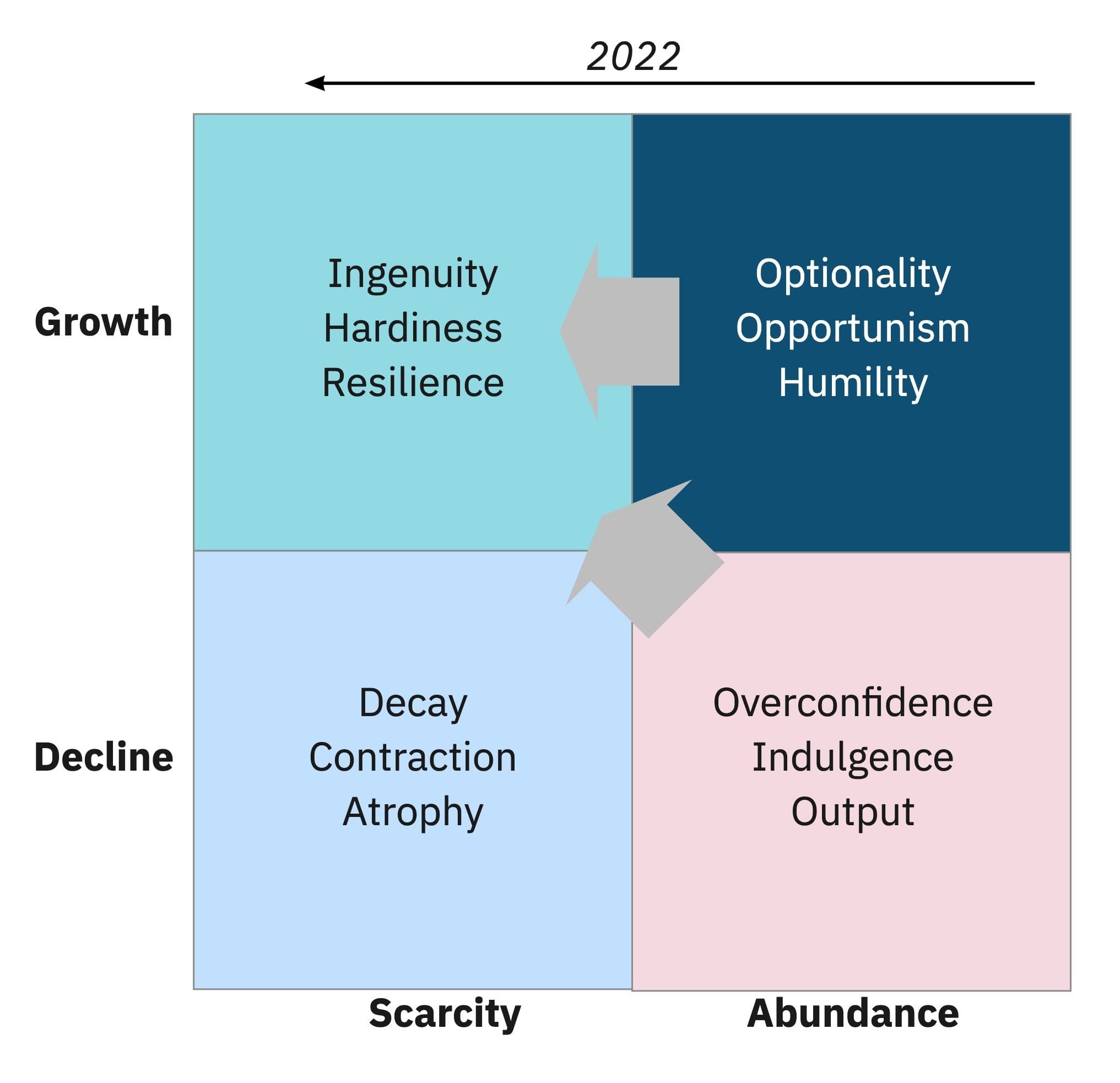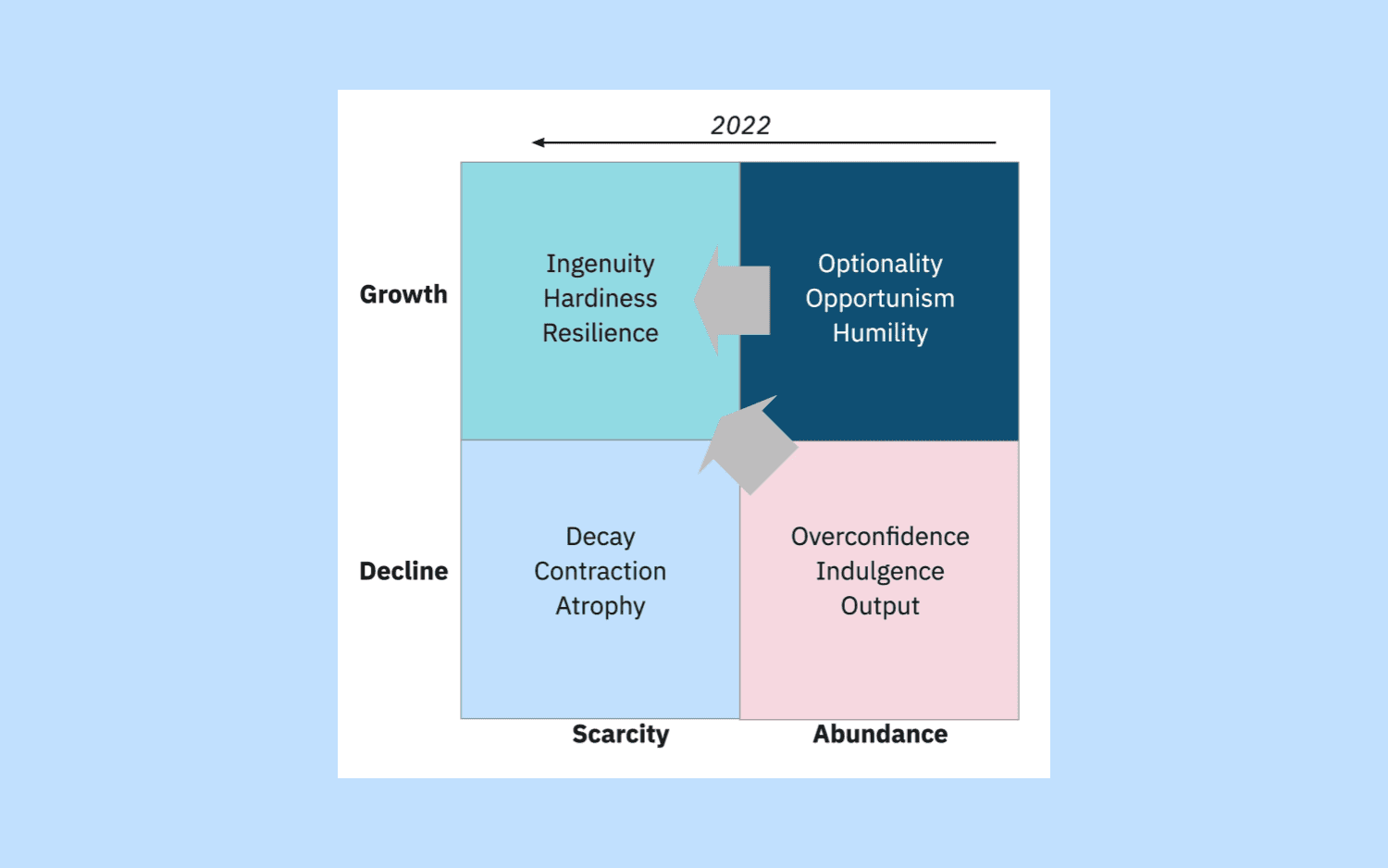Scarcity Requires a Renewed Focus on Leverage
2022 has ushered in a renewed need for leverage and focus. The tailwinds are no more. Companies must seek growth amidst scarcity.
October 2021. Grow. Grow. Grow.
I was nearing the end of a rewarding workshop with an Amplitude prospect. The team was genuinely excited about becoming more data-informed. The conversation was filled with talk of experimentation, checking assumptions, and becoming more diligent about “closing the loop” between bets and outcomes.
And then a senior-ish leader asked The Question. Paraphrasing:
“John, this all sounds great, but the business is doing better than ever. We’re hiring people like crazy. We’re launching new initiatives every week. I’m not sure there’s any real appetite for even questioning why things are working. It’s like we can’t miss a shot. Everything is up and to the right. How do we persuade senior leaders to change course?”
I did my best to answer, but it was a difficult question. How do you approach leaders during a period of rapid growth and challenge the status quo? It’s not easy.
The company ended up not buying Amplitude. They liked the product—in fact someone left that company and purchased Amplitude at their new company—but their original team was just too busy. When they did have a question, they were fine with throwing people (analysts) at the problem—even if the work was transactional, error-prone, and took forever.
June 2022. From abundance to scarcity
The incessant upward trajectory is no more. In 2022, and for the foreseeable future, it is going to be all about how companies navigate the shift from abundance to scarcity.
Organizations that enjoyed abundance over the last couple years (or decade), fall into three camps:
- Those that took advantage of the optionality and opportunities while remaining humble and grounded.
- Those that overindulged, and got a bit deluded and complacent. They underestimated the tailwinds, and overestimated their skills.
- A bit of both.
For the opportunists AND slightly deluded and complacent—there is going to be a shift to scarcity. Scarcity can be a trigger for ingenuity, hardiness, and resilience, OR decay, contraction, and atrophy. The stakes are VERY high. The challenge then becomes: how to avoid decline/contraction, and continue thriving amidst scarcity (see the diagram below).

Paradoxically, many of the companies that struggled because of the pandemic—that were forced to really innovate because of the headwinds—are on better footing than the companies that experienced the tailwinds. Some of the biggest Amplitude customer success stories over the last couple years were actually companies that were forced to scramble (see how AB InBev’s bridged the digital divide for two million SMBs).
Time for high leverage
To me, this really boils down to the idea of leverage.
Leverage is the ability to apply focus in one area and see an outsized impact. Instead of using brute force and numbers, you get strategic.
In good times, companies often try to do everything and anything. Because things are more likely to work than not (and if they don’t, you’d never know because you’re already on to the next thing), the focus shifts to output over outcomes. The strategy is very likely to be additive—essentially do whatever you were doing AND do these new things.
New hires tackle new challenges. New teams build new products. Do this AND this (not do this INSTEAD OF this).
With a rapid shift to scarcity, many companies will fall into the “do all the things, just with fewer people, and less effective tools” trap. In effect, even further reducing leverage (and likely burning people out).
Instead, the answer is to seek leverage in everything you do. How can your team have more leverage during this period of scarcity?
- Figure out what is working, what isn’t working, why things are either working or not working, and for WHOM it is working/isn’t working. This is common sense, of course, but lots of teams got so enamored with things being “up and to the right,” that they didn’t pause to reflect on their decisions. High-level KPIs are now going down, and everyone is scrambling. Don’t just try to answer these questions ad hoc and push them under the carpet. Use this situation as an opportunity to make this a regular part of how you work. With scarcity, you’re going to need to make every bet count. (Note: Questioning whether things are having an impact requires a lot of psychological safety. Stress that this is about seeking leverage, and not about downsizing.)
- With this kind of volatility, be especially cautious about big-batch planning that locks teams into prescriptive commitments. Yes, the cool certainty of a plan is compelling. But it is vital to reduce sunk cost bias, confirmation bias, and groupthink. Resist the temptation to create false certainty. Every initiative should start with an opportunity grounded in some amount of qualitative and quantitative data. Plan on taking multiple “shots” that don’t work as expected before you find something that works.
- See this as an opportunity to tweak your organizational chart (and tool stack) to be more aligned with growth, learning, and experimentation. I’m not sure companies can afford to have 3+ teams attempt to influence customer decisions in isolation, using different data sources and views of the customer. Whereas before you might have a never-ending parade of newly acquired customers to make up for retention gaps, now you’ll need to have a coordinated response. At Amplitude, we’re seeing teams collapse their tool stack down to save costs AND, perhaps more importantly, aid in new collaboration patterns. It’s all growth.
- Help your analysts do higher leverage work. Based on my discussions with analytics teams, they are feeling the crunch from all sides. First, leadership is asking them for tons of ad-hoc reports—many grasping for straws regarding the current situation. Second, like the team in my opening example, they were repeatedly being thrown at answering repetitive, transactional questions. Queue a hiring freeze. Considering lightening the load by offering some self-service tools to product and business teams. (See how Square lightened the load on their analysts).
- Counteract the uncertainty and volatility with a sense of regularity and routine. This may seem in contradiction to #2, but it isn’t. Nothing will sap morale more than a highly reactive, fly-swatter strategy. Swatting flies is not agility. A fallback response to this is to put together a prescriptive roadmap. No! Instead, create regularity and focus by aligning teams with actionable inputs that represent the persistent opportunities that will lead to sustainable growth. Build a “heartbeat” set of rituals like bet reviews, experiment design clinics, one-pager jams, and insight office hours. Keep the team relatively stable. Celebrate the rate of learning. You’ll need this to get through the tough times ahead.
Simply put—smarter, not harder
The return to scarcity for many companies will involve many shifts.
| Abundance | Scarcity |
| Acquire new customers | Retain/grow existing customers |
| Specialization and output | Collaboration and outcomes |
| Throw people at the problem | Work smarter, not harder |
| Up and to the right | What’s working? Why? |
Thriving is all about frugality, focus, economy of motion, and entrepreneurialism—leverage. And a soft landing. If your company has veered into the “believing your own hype” zone, you’ll need to capture that excitement, and crazy hard work, and channel it into working smarter not harder.
Some of history’s greatest companies emerged from a period of scarcity. The article lists Microsoft: 1975, Apple: 1975, 2001, Mailchimp: 2001, Airbnb: 2008, and Warby Parker: 2010 as key examples. We’ve all heard Mater artium necessitas (“The mother of invention is necessity”). Scarcity is an enabling constraint for invention and innovation.
So the question is how your company will seek leverage amidst scarcity?
Amplitude can help. We help teams learn faster. We help analysts focus on high leverage work, not writing 400 line retention SQL queries. We cut our teeth working with thrifty startups in the early 2010s before things went interstellar.

John Cutler
Former Product Evangelist, Amplitude
John Cutler is a former product evangelist and coach at Amplitude.
More from John





